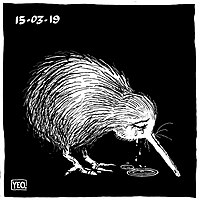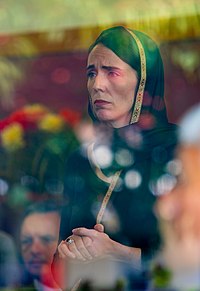Wikipedia:Wikipedia Signpost/2019-03-31/Community view
Wikipedia's response to the New Zealand mosque shootings
During Jumu'ah (Friday Prayer) on 15 March 2019, a gunman went to two mosques in Christchurch, New Zealand, and killed 50 Muslims, injuring dozens more. It was one of the worst mass shootings of modern times, and the worst in New Zealand since the 19th century New Zealand Wars. The Wikipedia article on the mosque shootings was created an hour and a half after the gunman began shooting, and had hundreds of edits in the first two hours as information trickled in. Twenty four hours and a thousand edits later it was a 1,300 word article; currently it's 5000 words with 320 references, written by 624 editors. Debate raged on the Talk page: should footage from the attacker's rampage be included? What about links to the (inevitable) manifesto? Do we make a Wikipedia page about it? (A resounding no.) When do we call the gunman a terrorist? Should we give him a Wikipedia page, since we have pages for Hitler and Stalin? (Another no.) Bizarrely, there was a huge debate over whether Queen Elizabeth II is "New Zealand's head of state" or "Queen of New Zealand".
After a mass shooting like this, we're often shocked and angry and want to know what we can do to help. Giantflightlessbirds is currently on a one-year grant-funded contract as New Zealand Wikipedian-at-large. Based at the National Library of New Zealand, he began photographing Wellington examples of the aftermath of the attacks: flags at half-mast, floral tributes, posters and graffiti in support of the Muslim community. There were only four photos in the relevant Commons category so he put out a call for people to donate their own photos. As of this writing, there are now 136 images, almost all from volunteers who'd never uploaded to Commons before.
Schwede66's photos are yet to come; the whole experience is still very raw for him. He was a volunteer marshal in Cathedral Square looking after 2,000 peaceful School strike for climate children ("easy job", he thought) when Police informed the marshals to get the Square emptied because "there is a gunman on the loose". The marshals knew this was happening at Al Noor Mosque, just 2 kilometres (1.2 mi) from the Square.
The artist Shaun Yeo drew the Crying Kiwi cartoon shortly after the attack, and reproductions of it began appearing in the floral tributes laid outside mosques all over the country. It was widely shared online, seen by over 3.4 million people in the first two days after the attacks. When approached, Yeo was happy to donate the cartoon to Commons under an open license; he said he "never intended to make money out of it".
The Christchurch City Council photographer Kirk Hargreaves took an incredible photo of Prime Minister Jacinda Ardern meeting with the Muslim community. After some negotiation they agreed to release the photo to Commons; in the last ten days it's had over 3 million views. It's a treasure to have at Commons; The Guardian has even published an article about the photo.
One problem has been over-vigilant Commons editors, trying to speedily delete photos of children's hand-drawn tributes and clip-art posters of support, claiming they're copyright violations. An uncleared EXIF cache in one new uploader's camera led to her receiving a stream of messages accusing her of copyright violation and threatening her with blocking. It's important we realise that during tragedies like this many newbies will arrive, wanting to do what they can to add images to the historical record. Many of them will be sad, angry, or grieving. We need editors to be patient, aware of Freedom of Panorama and de minimis, and willing to work with photographers to secure clearances for any derivative works rather than simply flag them for deletion.
Images are important. They will define these attacks to people around the world, to our descendants, to the history books. Too often the only images repeated after a tragedy are ones of anger and fear and hatred, and because these generate clicks they propagate through the media. As editors we have to be aware of this bias and work harder to tell the whole story, because Wikipedia is the first draft of history.






Discuss this story
Thanks for writing this. Just nominated the Ardern photo for FP after seeing this piece.
My typical response to comments about "over-vigilant Commons editors" is to urge cutting them some slack for devoting a lot of time to a mostly thankless task of dealing with complicated copyright-related rules most people don't have a great understanding of (freedom of panorama and de minimis being good examples). As with Wikipedia, that a copyright violation was made unintentionally or for this or that reason doesn't do much to mitigate its inevitable removal, but on Commons there are several different rules with many variations based on country, and the person doing the maintenance work is much more likely not to have the same first language as the uploader, so it can be hard.
But there's a reason I said that's just "my typical response" -- because I think you make an excellent point about context. We often lump all copyvios, original research, unsourced content, etc. together in terms of how we react. We revert on Wikipedia or tag for deletion on Commons, then leave a template (or something along those lines). Sometimes we vary that process based on assessments of good faith/bad faith. The subject of the contribution can provide context sometimes, but it's more likely to provide the context leading us to be harsher (original research added to some particularly controversial topic, for example). What we don't often do is consider context in the way you've described -- that for some topics like this, a contribution may be a means of coping with or making sense of terrible events and complicated feelings. And for that, we don't have a Twinkle template. — Rhododendrites talk \\ 17:14, 31 March 2019 (UTC)[reply]